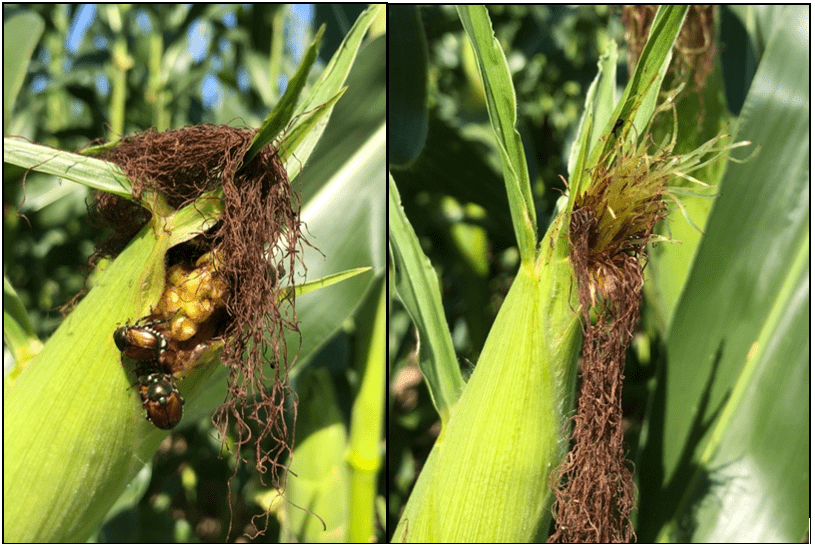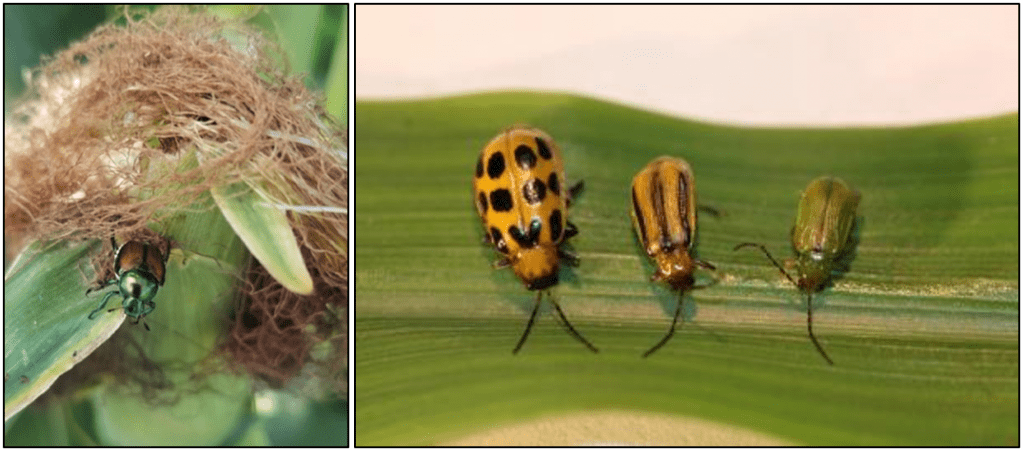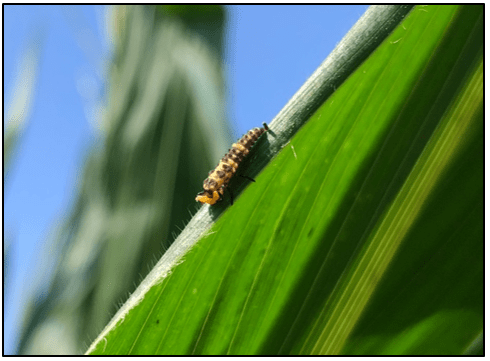Maria Cramer, Galen Dively, and Kelly Hamby
University of Maryland, Department of Entomology
It is not unusual to see groups of Japanese beetles feeding on corn silks, which is known as “silk clipping” Figs.1 and 2). While Japanese beetle numbers tend to peak in July, there are multiple beetles that may clip corn silks, and with later maturity field and sweet corn silking in August, it is important to still be on the lookout But how much of a concern is silk clipping, what should you be looking for, and what should you do about it?

Silk clipping is often not as much of a concern as it initially appears. If silks are clipped after pollination, which occurs within the first 4-5 days of silk emergence1, kernel set will not be affected2. If clipping reduces the number of kernels, the kernels may develop to be larger and offset the reduction in number2. However, under drought conditions, yield loss from silk clipping is more likely2,3.
Drought slows silk emergence and pollination, which means there is a longer window where silk clipping can hurt yield. Indeed, severe drought stress can cause incomplete silk emergence and cause a mismatch between pollen shed and silks that results in nearly blank cobs1. Drought can also make it harder for plants to compensate for poor pollination1. If leaf rolling begins in the early morning and continues until evening1, the field is stressed enough to be of concern and it is important to scout for silk clipping beetles during the first several days of silk emergence.
The culprits. Japanese beetles are the most noticeable silk clippers in Maryland because they are large, shiny, and congregate in groups (Fig. 3). They are a sporadic pest4 and their populations will vary yearly. However, their populations may be higher in corn following sod, soybean, or perennial ryegrass or clover covercrops4. Other beetles that may clip silk include the western, northern, and southern corn rootworm adults (Fig. 4)5. Western corn rootworm (WCR) has several look-alikes that do not clip silks, so make sure check the stripes; WCR will not have crisp black stripes, but instead has smudged stripes.

Scouting. Silking typically begins 3 days after tasseling5, so plan your scouting accordingly. You want to evaluate the silk stage and pollination. Silks naturally senesce about 10 days after emergence, browning and drying out. At this point, pollination can no longer occur1. To determine if green silks have been successfully pollinated, you can dissect the ear and do a shake test. Pollinated silk starts to discolor and drop away at the base of the silk where it attaches to the ear. Bob Nielson with Purdue Extension has produced a great video describing the pollination shake test: https://www.youtube.com/watch?v=K7DiwD4N0T0&feature=youtu.be
You should scout if pollination is incomplete. When scouting, make sure you sample both the edges and the interior (at least 40 feet into the field); while you may see alarming numbers of Japanese beetles on the edge of the field, there are usually much fewer inside the field2. Sample a minimum of 20 corn plants in 5 locations spaced evenly though the field. Count the number of beetles per ear and measure the length of the silks.
Thresholds. For Japanese beetles, three conditions need to be met to before an insecticide application will pay off: 1) there are three or more beetles per ear, 2) silks are clipped to less than ½ inch in length, 3) and pollination is less than 50% complete4 (most silks in the field are still green and/or shake test indicates about half of the silks are still attached). Conditions are similar for rootworm beetles, but the threshold is five or more beetles per ear.
Treatments. Because broad-spectrum insecticides may cause flare ups of other pests (for example, aphids or spider mites), only spray if thresholds are met. Pollen-shed is a time when there are large numbers of beneficials in the corn field doing important pest control work (Fig. 5), and foliar sprays may decrease their numbers.

For Japanese beetles, consider a perimeter spray if most of the damage is on field edges (where they tend to feed more heavily). Japanese beetles are difficult to control, but pyrethroids should provide some control (e.g., Baythroid®, Brigade®, Warrior II®, Hero®, etc.). Good adult corn rootworm control has been found for indoxacarb products (e.g., Steward®), pyrethroids (e.g., Warrior II®, Brigade, etc.), and neonicotinoid pyrethroid mixes (e.g., Endigo®)6,7. When using insecticides, always consult and follow the label.
If silk clipping by Japanese beetles is a consistent problem, consider cultural controls like avoiding ryegrass and clover cover crops. Because female beetles lay eggs more easily into soft ground, it is also possible to reduce egg laying in nearby fields by pausing irrigation during the peak of Japanese beetle activity4.
Additional Resources:
- Nielson, R. L. Silk development and emergence in corn. (2020). https://www.agry.purdue.edu/ext/corn/news/timeless/silks.html
- Steckel, S., Stewart, S. D. & Tindall, K. V. Effects of japanese beetle (Coleoptera: Scarabaeidae) and silk clipping in field corn. J. Econ. Entomol. 106, 2048–2054 (2013). https://academic.oup.com/jee/article/106/5/2048/878220
- Dean Culy, M., Richard Edwards, C. & Ronald Cornelius, J. Effect of Silk Feeding by Western Corn Rootworm (Coleoptera: Chrysomelidae) on Yield and Quality of Inbred Corn in Seed Corn Production Fields. J. Econ. Entomol. 85, 2440–2446 (1992). https://academic.oup.com/jee/article-abstract/85/6/2440/847063?redirectedFrom=PDF
- Shanovich, H. N., Dean, A. N., Koch, R. L. & Hodgson, E. W. Biology and Management of Japanese Beetle (Coleoptera: Scarabaeidae) in Corn and Soybean. J. Integr. Pest Manag. 10, (2019). https://academic.oup.com/jipm/article/10/1/9/5454734
- Townsend, L. H. & Bitzer, M. J. Silk Clipping Insects on Corn. (1982). https://uknowledge.uky.edu/cgi/viewcontent.cgi?article=1053&context=anr_reports
- DeVries, T. A. & Wright, R. J. Evaluation of Foliar Applied Insecticides for Control of Adult Corn Rootworm in Corn, 2015: Table 1. Arthropod Manag. Tests 41, tsw080 (2016). https://academic.oup.com/amt/article/41/1/tsw080/2658080
- DeVries, T. A. & Wright, R. J. Evaluation of Foliar-Applied Insecticides for Control of Adult Corn Rootworm in Corn, 2015C: Table 1. Arthropod Manag. Tests 41, tsw096 (2016). https://academic.oup.com/amt/article/41/1/tsw096/2658095
